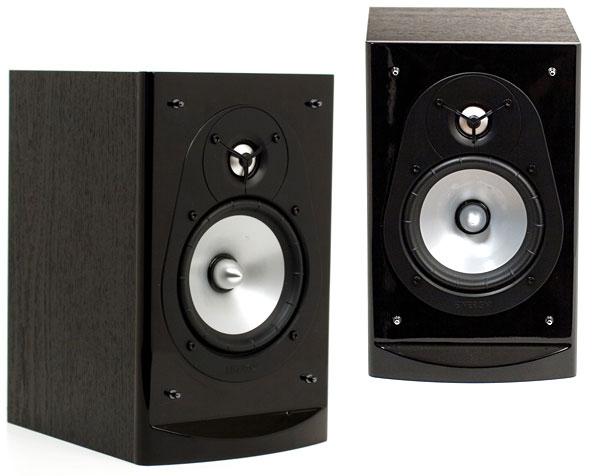| Columns Retired Columns & Blogs |
Energy Connoisseur CB-10 loudspeaker

The two-way Energy CB-10 ($269.99/pair) is a bass-reflex design. A large rear-firing port has an internal diameter of 2" and flares out to 2.75". The speaker uses a 1" aluminum-dome tweeter and a 5.5" woofer with a ribbed elliptical surround, the latter said to increase excursion, decrease distortion, and create a larger piston area for greater efficiency, making the CB-10 an easy match for amplifiers. The CB-10's frequency range is listed as 66Hz–20kHz, its in-room sensitivity as 90dB, and its nominal impedance as 8 ohms. In Energy's Convergent Source Module design, the tweeter and woofer are meant to act as a coincident source working together to provide wide bandwidth, constant dispersion, and a flat frequency response. In theory, this would all add up to easy setup and satisfying listening from anywhere in the room.
The CB-10 has a high-gloss black baffle, a modest cabinet veneered in black ash, and gold-plated five-way binding posts. At just under 9 lbs and measuring 11.4" H by 7.1" W by 8.5" D, the CB-10 is almost identical in size and shape to my PSB Alpha B1 ($299/pair), but the Energy feels a bit lightweight in comparison. I think it has something to do with that glossy baffle. Perhaps it's too glossy. Combined with the speaker's slick aluminum drivers and staid cabinet, the front baffle creates a dramatic but somewhat garish effect. Knocking on the cabinet's side panels produced a clearly audible resonance. The CB-10 was designed in 2008 by Klipsch Group's Canadian team of engineers.
Sound Quality
Twin Sisters' "Daniel" opens with a short progression of xylophone-like synth notes. Through the Energy CB-10 these bright notes rang out with great presence, but were a touch uncontrolled, diffuse, and ragged at the edges. Seven seconds into the song, I noticed some surprising background chatter—someone shifting positions in the studio, perhaps. And, at just about 2:30 into the song, when the synths, guitars, and cymbals reach a climax and are joined by Estella's ethereal voice, there was just a moment of distortion—a clear flaw in the recording that I wish could have been avoided. The Energys were digging deep into the mix.
In Heaven's second track, "Stop," sounds like a response to "Daniel" as guitarist Eric Cardona sings:
Here in another land, giving up all of my trials
Little did I think that you'd be doing the same for me . . .
Someday it's all over
Will I remember the scenery then?
Maybe it's foolish to want to be alone
We can learn something from sweet pop music. What I learned from "Stop" was that the Energy CB-10 was producing too much bass. The track opens with a couple of deliberate snare-drum strokes before the full band enters, and these strokes were distinctly heavier than I'm used to hearing, and not nearly as snappy. The hi-hat was nevertheless quick and bright, the voices clean and nicely delineated, but the bass guitar sounded bigger, fatter, and looser than I would have liked, and at times overpowered the rest of the music. Was this due to the tuning of the CB-10's big rear port?
The effect of this bass coloration depended on the music I listened to. There was a satisfying weight and pleasant darkness to Benoåt Delbecq's "Mille Nandie Remix," from the solo pianist's Circles and Calligrams (CD, Songlines SGL 1583-2), and The Multi-Purpose Solution's "Superman's Flying, Guns Are Shooting" was conveyed with awesome power and impact—the CB-10 could really rock! But too often, its heavy bass detracted from my overall listening experience.
I like the Energy Connoisseur CB-10. It definitely made music—and performed especially well with loud rock—but when I'm listening to the hi-fi, I want more than music. I want magic.
- Log in or register to post comments




































